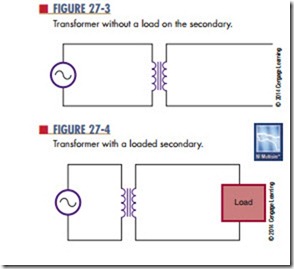mutual inductance
When a transformer is operated without a load (Figure 27-3), there is no secondary current flow. There is a primary current flow because the trans- former is connected across a voltage source. The amount of primary current depends on the size of the primary windings. The primary windings act like an inductor. Exciting current is the small amount of primary current that flows. The exciting current over- comes the AC resistance of the primary winding and supports the magnetic field of the core. Because of inductive reactance, the exciting current lags behind the applied voltage. These conditions change when a load is applied across the secondary.
When a load is connected across the secondary winding (Figure 27-4), a current is induced into the
secondary. Transformers are wound with the second- ary on top of the primary. The magnetic field created by the primary current cuts the secondary windings. The current in the secondary establishes a magnetic field of its own. The expanding magnetic field in the secondary cuts the primary turns, inducing a voltage back into the primary. This magnetic field expands in the same direction as the current in the primary, aid- ing it and causing it to increase, with an effect called mutual inductance. The primary induces a voltage into the secondary, and the secondary induces a volt- age back into the primary.
Questions
1. How does loading a transformer affect its operation?
2. What does a transformer act like with no load applied?
3. How is a transformer typically wound?
4. Define mutual inductance.
5. Describe how a transformer’s secondary induces a voltage back into its primary.
